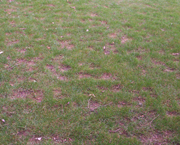
Features
Agronomy
Poa supina worth looking at as overseeding option on sports fields
March 28, 2011 By Mike Jiggens
ALTHOUGH Kentucky bluegrass remains the turfgrass of choice for natural
athletic playing fields, using the variety for overseeding purposes
isn’t usually the best idea.
It is slow to germinate and isn’t given a chance to fill in bare and worn spots if the field remains in play during the critical period of time immediately following overseeding.
Perennial ryegrass is preferred by many sports field managers as the seed of choice for overseeding purposes.
But another variety which warrants a look is poa supina, or supina bluegrass.
Kathleen Dodson of the University of Guelph examined poa supina’s attributes in February during the 20th annual Ontario Turfgrass Symposium in Guelph.
“If you want to establish a brand new athletic field, I highly recommend using Kentucky bluegrass, but, if you’re trying to fill in weak stands of turf, perhaps Kentucky bluegrass isn’t where you should be spending your money for overseeding,” she said.
As effective as perennial ryegrass is for overseeding bare spots on athletic fields, one of its shortcomings is its susceptibility to winter kill. Its quick rate of germination, low cost and moderate wear tolerance are qualities which make it an ideal choice for overseeding purposes.
“So its seedlings are OK with being trampled on,” Dodson said.
Poa supina, on the other hand, which is also wear-tolerant, tends to fare better during the winter months. Originally from the region of the German Alps, the species is acccustomed to colder temperatures as well as higher altitudes.
“This has caused it to adapt to have a very early spring greenup and a very late dormancy.”
It creates stolons and spreads rapidly, and can recover quickly from traffic stress. It is actively growing in the early spring following snow melt.
Research on poa supina in North America has mainly focused on establishing fields with the species. Dodson said research shows that as little as 10 per cent of poa supina in a seed mix will produce a field which is predominately poa supina within the first few years. It has a strong ability to self seed itself and will produce seed heads for the first two years after being seeded under mowing conditions. After two years, it doesn’t produce as many seed heads. Unlike poa annua, it slows down after two years of continually being mowed off.
A potential shortcoming with poa supina is its shallow rooting. Research shows its watering requirements are similar to other high-quality turfgrasses such as Kentucky bluegrass and creeping bentgrass, but it has significantly less root mass under a depth of 20 to 30 centimetres. Most of its root mass is above the 20-centimetre depth.
Over time, if a sports field continues to experience drought stress, poa supina will not be as drought-tolerant as other species such as creeping bentgrass or red fescue, Dodson said.
Its colour may also be a drawback to potential users. Lime green in colour, it contrasts with the darker green turfgrasses of North America.
There are currently two cultivars of poa supina available from the German Alps, but the potential exists for breeders to create more cultivars that would be more desirable for North American standards.
Poa supina seed is also comparatively expensive.
In her research, Dodson overseeded with five different rates of poa supina in which each of the test plots received six kilograms per 100 square metres of perennial ryegrass. The rates of poa supina used were zero kilograms, half a kilogram, one kilogram, two kilograms and four kilograms.
“The idea here is that I’m hoping I can figure out what is the minimal amount of supina bluegrass I can use in an overseeding program that will still introduce this super-competitive, highly traffic-tolerant species into southern Ontario athletic fields.”
Realizing not all athletic field managers can afford to overseed more than once in a season, she looked at the amount of seed over time and at two frequencies. One overseeding was done in the spring in which she put down all the seed at once, and then the same amount of seed was used later, but in three separate applications. She also considered that not everyone can afford to mow weekly, so mowing heights of 1.5 and three inches were studied. The different mowing heights were examined to see how poa supina would enter the system and how it would behave.
Since the research was conducted on trial plots and not actively-used fields, traffic was simulated using a wear machine to mimic the amount of traffic produced by six football games a week.
With only a single season of data, she found the three-inch mowing height and two-kilogram overseeding rate produced 100 per cent cover.
“Overseeding does appear to work, but doing it more frequently will supply more seed during periods when it is needed most.”
Dodson said if turf managers take care of their turf, their turf will take care of the weeds.
“If we can focus on getting our turf growing, then hopefully the turf can take care of the weeds themselves and will outcompete them.”
Overseeding introduces desirable seed into the turfgrass community. The more desirable species in the community, the easier it is to oust the undesirables, such as weeds, she said.
Print this page